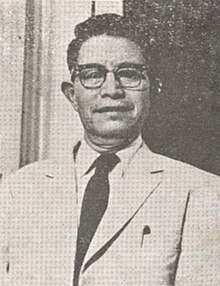Kevichüsa Angami
Kevichüsa Angami | |
|---|---|
 | |
| Member of Parliament, Lok Sabha | |
| In office 1989–1990 | |
| Preceded by | Shikiho Sema |
| Succeeded by | K. Asungba Sangtam |
| Constituency | Nagaland |
| Personal details | |
| Born | 15 April 1903 Khonoma, Naga Hills District, Bengal Presidency, British India (now Khonoma, Kohima District, Nagaland, India) |
| Died | 1990 |
| Political party | |
| Spouse(s) | Germanthangi (Mannie) (m. 1931) |
| Children | 10, including Chalie and Tubu |
| Source: [1] | |
Kevichüsa Angami MBE (born 15 April 1903 – 1990) was a Naga politician. He was a Member of Parliament, representing Nagaland in the Lok Sabha the lower house of India's Parliament.[1][2] He is regarded as the first Naga graduate. Kevichüsa was conferred the Member of the Most Excellent Order of the British Empire (MBE).[3]
Early Life[]
Kevichüsa Angami was born on 15 April 1903 to an Angami Naga family from Khonoma. He did his graduation from St. Paul's Cathedral College, Calcutta.
His father Nisier Angami was the first Christian convert from Khonoma village. Kevichüsa was educated at Baptist Mission School.[3]
Political Career[]
In the 1969 Nagaland Legislative Assembly election, Kevichüsa stood as the United Front's candidate from Dimapur Town and Dimapur Outer constituencies. He lost in both seats. While Kevichüsa polled 706 votes in the Dimapur Outer constituency, the Naga Nationalist Organisation candidate secured 3186 votes.[4]
Member of Parliament[]
In 1971, as a candidate of the United Front of Nagaland, Kevichüsa stood against S. C. Jamir in the Lok Sabha elections. Jamir, then, was the Deputy Minister of Agriculture in the Indira Gandhi government.[5] During the election campaign, Kevichüsa attacked the Naga Nationalist Organisation for its failure to implement the "16 Point Agreement" with the approval of the Indian government. He promised to work towards the negotiation of a new political settlement. Kevichüsa registered an overwhelming victory with 102,596 votes (63.3%) defeating Jamir.[6]
Personal life[]
Kevichüsa married Germanthangi on 15 October 1931. Together the couple had six daughters and four sons.
Legacy[]
In 2017, his family-run foundation–The Kevichüsa Foundation–instituted the A. Kevichüsa Citizenship Award to recognise an individual or group from the indigenous community who have 'championed, demonstrated, and embodied' the ideal of citizenship.[7]
References[]
- ^ John Thomas (2015). Evangelising the Nation: Religion and the Formation of Naga Political Identity. Routledge India. p. 103. ISBN 9781317413998.
- ^ T Raatan (2003). Encyclopaedia of North-East India. Kalpaz Publications. p. 95. ISBN 9788178350684.
- ^ a b Chophy, G. Kanato (2021). Christianity and Politics in Tribal India: Baptist Missionaries and Naga Nationalism. Albany, New York: State University of New York Press. p. 10. ISBN 978-1-4384-8581-2.
- ^ The Times of India News Service (13 February 1969). "Good show by Naga ruling party is pleasant surprise". The Times of India. p. 9.
- ^ "Brisk Polling". The Times of India. 3 March 1971. p. 1.
- ^ Means, Gordon P. (1971). "Cease-Fire Politics in Nagaland" (PDF). Asian Survey. 11 (10): 1005–1028 – via JSTOR.
- ^ "Naga disability rights activist receives 'A Kevichusa Citizenship Award'". Medolenuo Ambrocia. EastMojo. 30 November 2020. Retrieved 26 September 2021.
External links[]
- Indian National Congress politicians from Nagaland
- Lok Sabha members from Nagaland
- 5th Lok Sabha members
- 1903 births
- Nagaland politician stubs